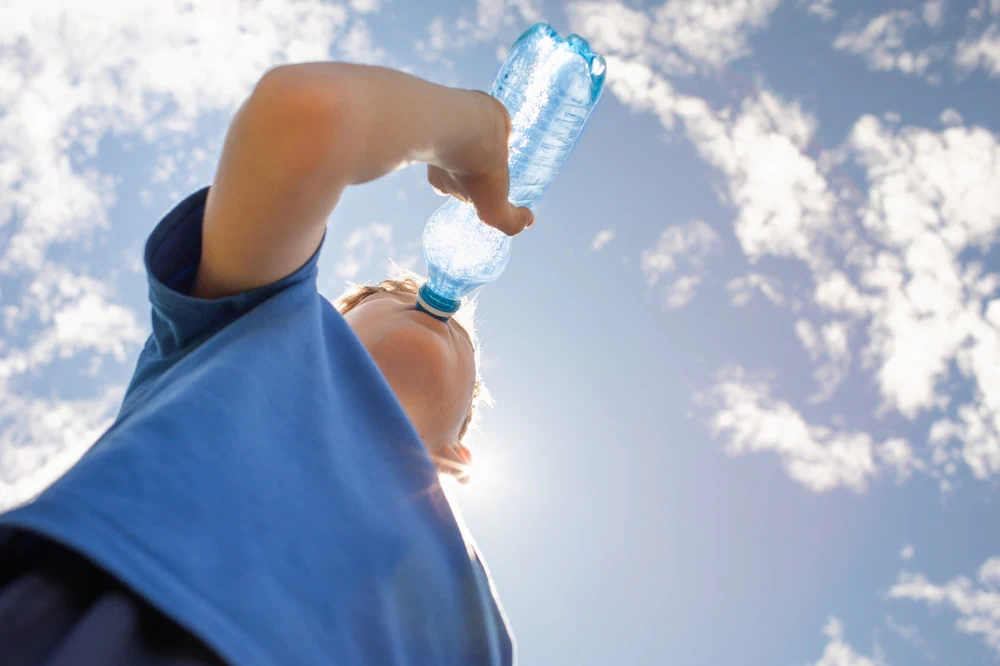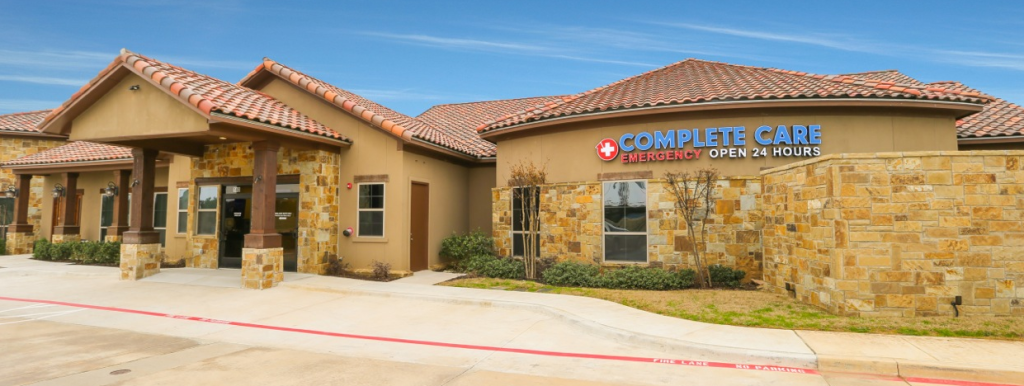Signs of Dehydration in Kids: When to Bring Them to the ER
Dehydration
•
Jul 3, 2025
Reviewed by:

Children lose fluids faster than adults due to their smaller body size and higher activity levels, making them especially susceptible to dehydration when they’re sick, active in hot weather, or simply not drinking enough throughout the day. Recognizing the warning signs of dehydration in kids early can make all the difference in getting them the care they need.
Here’s what to watch out for:
- Dry mouth and sticky saliva
- Decreased or dark urination
- Lethargy and irritability
- Sunken eyes and dark circles
- Skin tenting
- Absence of tears when crying
- Sunken soft spot (fontanelle)
- Rapid heartbeat and breathing
If you notice any combination of these symptoms in your child, especially if they persist or worsen despite offering fluids, don’t hesitate to seek immediate medical care at a Complete Care ER location.
For life-threatening situations, please call 911.
How do I know if my child is dehydrated?
Here are common signs of dehydration that can help you know if your child needs medical care for dehydration.
Dry mouth and sticky saliva
One of the early signs of dehydration in pediatric patients is a dry mouth and thick, sticky saliva. You can check by gently lifting your child’s lip and touching their gums — they should feel wet and slippery if your child is well-hydrated.
Dehydrated kids might say their mouth feels “yucky” or may not want to eat because swallowing is uncomfortable. You may also notice them licking their lips a lot or asking for drinks more than usual. This is often one of the earliest signs of dehydration, so it’s a helpful warning that your child needs more fluids before things get worse.
Decreased or dark urination
Watching your child’s bathroom habits can help you spot signs of dehydration. Well-hydrated kids usually urinate every 3–4 hours, and their urine should be pale yellow or almost clear. When a child is dehydrated, they use the restroom less often, and their urine gets darker, ranging from deep yellow to amber.
For babies in diapers, you should see at least 6 wet diapers in 24 hours. Try to keep track of diaper changes or bathroom visits, and check the color when you can. If your child hasn’t urinated in 8 hours or more, it’s a serious sign of dehydration and they need medical care right away.
Lethargy and irritability
Dehydration can impact your child’s energy and mood, often making them act differently than usual. A normally active child might seem very tired, want to lie down a lot, or lose interest in their favorite toys and activities. Some kids may become extra fussy, cranky, or hard to comfort. Babies might cry more but with a softer, weaker cry, and toddlers may have more tantrums or seem unusually clingy.
These changes happen because dehydration affects brain function, body temperature control, and energy levels. These are common signs of dehydration in kids with a stomach bug or RSV, since illness causes even more fluid loss.
Sunken eyes and dark circles
When your child is dehydrated, the fat pads behind their eyes shrink, making their eyes look sunken or hollow. Their eyes may seem bigger or stick out more, and dark circles can appear underneath. The skin around their eyes might also look thin or papery. This change is easier to spot in babies and young kids, since their faces are usually full and round. If you see this, it usually means moderate to severe dehydration and needs quick medical attention.
Skin tenting
The skin pinch test, also called skin tenting, is an easy way to check for dehydration at home. Gently pinch a small fold of skin on the back of your child’s hand, forearm, or just below the collarbone, then let go. If your child is well-hydrated, the skin should quickly snap back into place. If they’re dehydrated, the skin will stay raised or “tented” for two seconds or more before slowly going back to normal.
This happens because dehydration makes the skin less stretchy. The slower the skin returns to normal, the more serious the dehydration. It’s a helpful test you can do anywhere to get a clear sign of how hydrated your child is.
Absence of tears when crying
It might seem strange, but tears are actually a good sign that your child is well-hydrated. When kids are dehydrated, they may cry but have little or no tears, even if they’re really upset. That’s because the body cuts back on tear production to save fluids.
If your child is clearly upset — from pain, frustration, or sadness — but isn’t making many tears or has dry crying, it could be a sign of dehydration. Just remember, very young babies (under 2–3 weeks old) naturally don’t make many tears yet, so this sign is more useful for older infants and children.
Sunken soft spot (fontanelle)
In babies under 18 months, the soft spot on top of the head (called the anterior fontanelle) can help show if they’re dehydrated. When a baby is well-hydrated, this spot feels fairly firm and even with the rest of the skull, though it may gently pulse with their heartbeat. If a baby is dehydrated, the soft spot may look and feel sunken or lower than the surrounding bone.
You can check by lightly running your finger over the top of their head — it shouldn’t feel like a deep dip or crater. A sunken soft spot is a serious warning sign and needs immediate medical attention, as it means the baby has lost a lot of fluids.
Rapid heartbeat and breathing
One of the important signs of dehydration in kids after vomiting is a fast heart rate or rapid breathing. When a child is dehydrated, their heart has to work harder to move the smaller amount of blood through their body. You might notice their chest rising and falling faster than usual or feel their heart beating quickly when you hold them. Their breathing may also seem shallow or a bit strained as their body tries to keep up.
These signs can be easy to miss at first, but are important to watch for, especially after vomiting, when kids can lose fluids quickly. If your child is breathing fast while resting or their heart is racing without a clear reason, it may be a sign they need medical attention.
When should I take my child to the ER for dehydration?
While mild dehydration can often be managed at home with increased fluid intake, there are certain extreme dehydration symptoms that indicate your child needs immediate emergency medical care, including:
- No urination for 12+ hours: Complete absence of wet diapers in infants or no bathroom trips in older children indicates severe fluid depletion
- Extreme lethargy or unresponsiveness: Child is difficult to wake up, seems confused, or doesn’t respond normally to your voice or touch
- Severe vomiting or diarrhea: Unable to keep any fluids down for more than 4-6 hours, or frequent watery stools that prevent rehydration
- Signs of shock: Cold, clammy skin, rapid weak pulse, dizziness, or fainting spells
- High fever with dehydration signs: Temperature over 102°F combined with any dehydration symptoms
- Significantly sunken fontanelle: In infants, the soft spot appears markedly depressed and doesn’t improve with positioning
- Dry mucous membranes: Inside of mouth, gums, and tongue appear completely dry with no saliva production
- Skin tenting lasting more than 3 seconds: Pinched skin remains elevated for an extended period, indicating severe fluid loss
- Behavioral changes: Extreme irritability, inconsolable crying, or unusual agitation that’s out of character
Emergency room doctors can quickly check how serious dehydration is by examining your child. If drinking fluids isn’t enough, they can give fluids fast through an IV drip for dehydration to rehydrate them.
How to prevent dehydration in children
Prevention is always the best approach when it comes to childhood dehydration. By establishing good hydration habits and being proactive during high-risk situations, you can significantly reduce your child’s chances of becoming dehydrated.
Daily fluid recommendations
Children’s fluid needs vary by age, activity level, and climate.
- Toddlers need about 4–5 cups of fluids daily
- School-age children need 5–7 cups
- Teenagers require 8–10 cups
During hot weather, illness, or increased physical activity, these amounts should be increased. Water is the best choice for everyday hydration, though milk and diluted fruit juices can also contribute to fluid intake.
High-risk situations
Pay special attention to hydration during fever, vomiting, diarrhea, or any illness that affects appetite. Hot weather and physical activities like sports, playground time, or swimming also increase fluid needs. Air travel and heated indoor environments can be surprisingly dehydrating. During these times, offer fluids more frequently and don’t wait for your child to ask for a drink.
Smart hydration strategies
- Make water easily accessible by providing your child with their own water bottle and refilling it regularly throughout the day.
- Offer fluids before, during, and after physical activities.
- For picky drinkers, try adding slices of fruit to water or offering ice pops made from diluted fruit juice.
- Establish regular drink times with meals and snacks, and model good hydration habits yourself.
What to avoid: Limit caffeinated beverages, excessive fruit juices, and sugary drinks, as these can actually contribute to fluid loss or provide empty calories. Sports drinks are generally unnecessary for children unless they’re engaged in prolonged, intense physical activity. During illness, avoid dairy products if they seem to worsen nausea or stomach upset.
By staying proactive about your child’s fluid intake and recognizing when extra hydration is needed, you can help prevent dehydration before it becomes a concern. Remember, maintaining good hydration is much easier than treating dehydration once it occurs.
When your child shows signs of dehydration, choose Complete Care.
When you’re concerned about signs of dehydration in kids, Complete Care’s emergency rooms are equipped with emergency-trained specialists who understand the urgency of childhood dehydration. Our experienced medical teams can quickly assess your child’s condition, provide immediate IV rehydration when needed, and give you the peace of mind that comes with professional care.
With multiple convenient locations in Austin, Corpus Christi, Dallas/Fort Worth, East Texas, Lubbock, San Antonio, and Colorado Springs, we’re here 24/7 to help your family when every minute counts. If you notice any signs of dehydration in your child, don’t hesitate — visit your nearest Complete Care location for prompt, compassionate treatment that gets your little one back to feeling their best.
More Helpful Articles by Complete Care:
- What Do Diverticulitis Symptoms Feel Like?
- What Does Your Abdominal Pain Location Mean?
- Your Guide to Burn Blister Care
- What Causes Symptoms of High Cholesterol?
- Wire Grill Brush Danger and What to Use Instead
